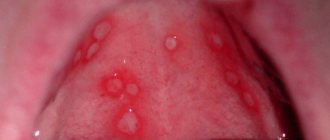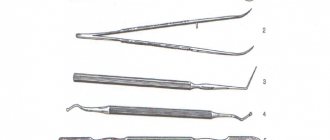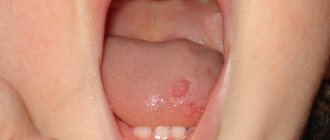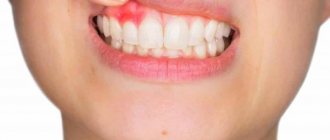If a person, who suddenly once felt unwell, has red spots in his mouth (on the palate, lips, gums and other mucous membranes), it may well be that this is not a reason to panic, but just a hint that it is worth contacting the nearest dentist .
For in the name of this profession, the first part of the word: “stoma” means not only teeth, but also the mouth in general, while the word dentist itself is a specialist in oral diseases. Including those that are accompanied by the appearance of spots and rashes of any color.
Causes of occurrence and mechanism of occurrence
The appearance of red spots in the oral cavity and in areas adjacent to it can be due to various reasons.
For example, a vascular reaction due to:
- cerebral or vascular accident;
- acute poisoning;
- entry into the body of an acutely infectious infectious agent (virus) or activation of its own chronic flora (microbial, fungal, mycoplasma or protozoal infection of the pharynx).
The second category of reasons for the appearance of spots within the oral cavity is cases of allergies.
Thirds include damage to the mucous membranes with discoloration of their surface layers. As in the case of exposure to too high or too low a temperature, and in similar situations.
Strictly speaking, all episodes of changes in tissue color in the area under the dentist’s control, perceived as the appearance of red spots and dots in the mouth, are caused by vascular disorders in it, occurring at different rates.
Thus, hyperemia when exposed to excessively high temperatures appears almost instantly due to vasomotor paresis of the capillaries, while cyanosis with a purple tint when exposed to extremely low temperatures develops after some time necessary to slow down the blood flow or complete stasis of the blood in the damaged area.
Red spots on the palate due to acute infections
Despite the common mechanism for the appearance of red spots on the palate due to injury, chronic intoxication (smoking) or due to acute infection in the mouth, their characteristics will be significantly different from each other.
If the spots on the palate of a smoker are similar to spider veins and are not accompanied by a clinical picture of acute damage to the body, then during an infectious process it is a rash characteristic only of a specific disease in combination with general clinical symptoms.
Thus, with chickenpox, the rash has the appearance of bubbles on a hyperemic conical base, located not only on the palate, cheeks, tongue and other mucous membranes in the mouth, but also protruding to the surface throughout the body.
In addition to red spots and a polymorphic rash in and around the mouth, stomatitis of herpetic etiology manifests itself:
- regional lymphadenitis;
- hyperthermia;
- symptoms of intoxication in the form of headache, body aches, weakness and similar phenomena;
- pain in the mouth from eating.
In a flu-like state, toxic effects come to the fore, but the appearance of a rash is also common.
Unlike a viral rash, when a chronic microbial or fungal infection is activated, the spots will have a less impressive appearance. If a viral rash is like a volcano exploding the mucous membranes from the inside, then a microbial and fungal rash looks less militant.
Despite a significant burning sensation in the areas where painful points are located and discomfort during eating, candidiasis does not occur as violently as chickenpox. Its distinctive feature is a typical white yeast coating on the formed elements of the rash.
The characteristic appearance of a scarlet fever (streptococcal) rash is red pinpoint spots not only in the mouth, but also around it, in the corners of the mouth, on the lips and cheeks, as well as on the skin of the body, with a tendency to merge. The nasolabial triangle is free of rash.
The sequence of appearance of the rashes: face, arms, upper body. A skin test is indicative: when a hard object is passed over the surface, a white stripe remains, then the rash appears again, confirming the diagnosis, as well as symptoms of severe intoxication.
If the cause is poisoning
A classic example of a poisoning rash is a meningitis rash.
With this disease, which is infectious in nature, capillary paresis occurs with the appearance of hemorrhages of various sizes and shapes (red, black, white dots) in various parts of the body, including in the mouth.
The difference between hemorrhages and spots of a different nature is that when the affected area of the skin or mucous membrane is pressed or stretched, they turn pale and disappear, only to appear again after the end of the exposure.
Allergy sign
Due to the expansion of the geography of travel of citizens abroad and the approaching of East Asian and other exotic cuisines closer to the consumer, as well as the introduction of artificial and herbal food additives into food, rashes with a complex etiology may appear.
These are symptoms of poisoning in the form of pain and colic in the abdomen, but with signs of allergy coming to the fore: severe skin itching against the background of more or less significant swelling of the tissues of the extremities, face and oral cavity with protrusion of rash elements of varying degrees of hyperemia to the surface.
A fairly typical concomitant manifestation of allergies is suffocation and nasal congestion of varying severity due to swelling of the respiratory system.
The appearance of hyperemia (spread or in the form of red spots and dots in the mouth and lips), similar in appearance to a burn, is possible not only with food allergies, but also with:
- household allergies;
- with the mistaken use of liquids of unknown composition and in similar situations, especially by children.
What other diseases can cause the appearance of red spots on the palate in children and adults?
If red spots appear on the palate of yourself or your child, be sure to consult a doctor.
A person can encounter the problem of redness of the palate only once during his life or periodically, which is due to the nature of the disease that has these symptoms. Relapses include herpes, thrush, and enterovirus infections.
Once the body has been affected, it is impossible to get rid of them. When conditions are favorable for viruses and bacteria, the disease worsens, so it is important to take preventive measures to suppress the pathogen.
The characteristic red rash in the mouth is one of the symptoms of other diseases.
- of tuberculosis is flat red spots on the oral mucosa. Over time, the reddish or red-yellow inclusions merge to form plaques. The surface of the formations is heterogeneous, the color becomes red-bloody.
- ARVI is recognized in particular by red spots on the soft palate and tongue. Associated symptoms are characteristic of acute respiratory diseases.
- Oncology, among a large number of signs, has one more, which is related to the oral mucosa. A small ulcer forms on the palate, increasing in size over time. However, at first it does not cause discomfort, there are no painful sensations. Reaching large volumes, the ulcer begins to interfere, and difficulty is experienced when swallowing.
- Vitamin deficiency is characterized by a deficiency of vitamins and minerals important for all body systems. Their deficiency weakens protective functions and increases vulnerability to bacteria, fungi, viruses and infections. Red spots with vitamin deficiency are located locally on the skin and mucous membranes, without spreading intensively to neighboring areas.
- Herpes is a viral infection that once it enters the body, does not disappear. The disease worsens against the background of weakened immunity. A characteristic sign: small red spots on the mucous membrane, increasing in size, transforming into small bubbles with liquid inside.
- Chickenpox is diagnosed mainly in children under 14 years of age, but this does not exclude the risk of infection in adults. Not only the skin, but also the mucous membranes are covered with spots. In the mouth you can first find small red dots, which turn into bubbles and very soon burst. This results in gray or yellow ulcers with redness around the circumference.
- Measles is characterized by a rash on the skin and mucous membranes, high fever, general physical weakness, and lack of appetite. The affected area even extends to the mucous membrane of the eyes. Initially, white spots form in the mouth behind the cheeks, and as it moves to other areas, the rash acquires a bright red tint.
- Infectious mononucleosis is recognized by its extensive affected area; spots cover not only the palate, but the entire oral mucosa. There is a soreness in the larynx, and the tonsils increase in size. Breathing becomes difficult due to nasal congestion. Characteristics of the spots: the color is bright, the parameters are impressive, they appear more often along the palate, and quickly spread to other areas.
- Scarlet fever is recognized by red spots that are localized on the soft palate. Other signs of the disease: headache, fever, nausea, pain when swallowing. The tongue becomes crimson in color, the mucous membrane is inflamed, and the rash on the skin is very itchy.
A similar mechanism for the appearance of spots in each individual case still has characteristic features and accompanying signs by which the diagnosis is made. But sometimes even the experience and colossal knowledge of a specialist do not make it possible to diagnose the problem without laboratory tests. Therefore, you should not postpone going to the clinic so that the situation does not get out of control.
Red spots and sores on the gums and cheeks
The most common cause of such localized redness is gingivitis, which does not necessarily have to be of viral, bacterial or mycotic etiology.
It may also be a consequence of slowing down the healing processes of microdamages as a result of conditions that weaken the body:
- tuberculosis;
- AIDS;
- oncological pathology;
- aging.
The morphology of its manifestations is varied - from flat spots to deep narrow holes in the gums and ulcers with undermined edges, painted in various shades of red.
Red, inflamed areas of the mucous membrane on the cheeks are often the result of biting, which can be either a random one-time act or a habit that has become a system.
About red spots on the tongue and red tongue
Red spots that appear on the tongue can be a signal of disorders in the body when:
- allergic reactions;
- eating food that hurts the tongue physically and chemically;
- presence of bad habits;
- lack of oral hygiene;
- dental diseases;
- oppression of the body, physical or mental.
A separate category of causes consists of diseases with changes in the surface of the tongue.
With mononucleosis, this is the appearance of pinpoint hemorrhages, which are also present on the soft and hard palate. The disease has all the features of an infectious process: lymphadenitis, hyperthermia up to 40°C, symptoms of severe intoxication.
The same violent symptoms are also characteristic of exudative erythema, which ends with the transformation of red spots into blisters filled with serous fluid, after opening of which ulcers are formed that merge together. The process develops with the involvement of the lip mucosa.
Changes in both the color and the tongue itself are characteristic of a variety of pathological processes: with syphilis it is a crimson chancre, with Kaposi's sarcoma - moderate pain and the presence of non-protruding red spots with a bluish tint in the area of the tongue root, with anemia, red spots stand out in contrast on an almost white tongue spots accompanied by pronounced pallor of the gums.
If you notice a rash in your mouth
Each case of a rash in the mouth, regardless of the primary or recurrent occurrence of the phenomenon, should be carefully examined by a dentist, even without life-threatening symptoms. Because a sore throat in one family member can turn out to be a highly contagious disease that puts the whole family to bed.
Under no circumstances should you delay an independent visit to the doctor, and if hyperthermia appears, increasing signs of swelling of the respiratory tract (even minor difficulty breathing), and especially nausea, vomiting and other cerebral phenomena, an ambulance must be called without fail and immediately .
In no case should the patient make an independent decision about his condition, much less attempt self-medication - all diagnostic and therapeutic measures must certainly be agreed upon with medical specialists.
For a painless and harmless-looking formation in the mouth can become the beginning of an oncological pathology.
Is treatment always necessary?
The general approach to treatment depends on the provoking cause.
If in the case of an allergy to toothpaste it is enough to replace it with another, then Kaposi's sarcoma requires radical surgical excision followed by radiation and chemotherapy.
In cases where the appearance of red spots is a symptom of an acute infectious disease, a course of therapy is carried out aimed at destroying or suppressing the pathogen that caused it.
Considering that the causative microorganism may be a representative of one of the many classes of pathogens, therapy is carried out using the following means:
- antimicrobial;
- antiprotozoal;
- antiviral;
- antifungal.
That is, the drug is selected taking into account the anatomy and physiology of the pathogen and its sensitivity to a particular category of active substances of medications.
These may be substances from the group:
- antibiotics;
- sulfonamides;
- nitrofurans;
- anti-tuberculosis action and others.
Considering that the changes produced in the body by the invasion of a pathogen are great and varied, in addition to means to suppress the cause of the disease, there may be a need for means with the effect of:
- antihistamine;
- painkillers;
- decongestant;
- anti-inflammatory;
- antipyretic or complex.
A separate category consists of emergency aid and resuscitation means, including the use of Euphyllin, Prednisolone, Adrenaline and others.
Most often, outpatient treatment is used using a complex of multidirectional agents. In cases that raise uncertainty about the possibility of outpatient therapy or present diagnostic difficulties, the patient is hospitalized in the department of the appropriate profile.
Conditions that cause depletion of the immune system and the entire body as a whole are treated with appropriate methods, starting with vitamin therapy and detoxification methods, including immunomodulators and replacement therapy, and ending with hardening procedures and exercise therapy, massage and similar measures for overall health improvement.
Chronic diseases require particularly persistent and methodical treatment using various categories of drugs, including hormonal ones.
Preventive measures to prevent the appearance of spots and rashes in the oral cavity and adjacent areas are also aimed at maximizing health promotion from childhood and imply timely and careful care of this area of the body, competent, nutritious and varied nutrition, elimination of harmful addictions, and in the presence of chronic diseases of any nature and their treatment.
Visiting a dentist at least twice a year who knows what to do with stains in the mouth and outside it should become the same habit as brushing your teeth twice a day.
Many argue that the eyes are the mirror of the human soul, in which case the tongue is a reflection of the health of the whole organism. This statement is by no means an exaggeration. The fact is that the color and general condition of the tongue may indicate the development of serious pathologies that pose a danger to human health.
Hyperemia of the pharynx is
Saratov State Medical University named after. IN AND. Razumovsky (SSMU, media)
Level of education - Specialist
1990 - Ryazan Medical Institute named after Academician I.P. Pavlova
Throat hyperemia is a common phenomenon. It occurs not only against the background of a cold, but also under the influence of various irritating factors. In some people, the mucous membranes of the throat change color under the influence of dyes or certain drinks, while in others this may result in an allergic reaction. Next, we will talk about what can cause hyperemia and how to deal with it.
Why does the pharynx change color?
In normal condition, the color of the mucous membranes of the mouth and throat is light pink. Redness in the pharynx appears under the influence of various factors. The color of the mucous membrane may be slightly red or have a rich scarlet tint.
In the latter case, people often think that they are seriously ill. In reality, this is not at all the case. A red tint to the mucous membranes of the throat can occur under the influence of a person’s lifestyle, i.e. if he has certain eating and other habits.
The main reasons for changes in the color of the throat mucosa are as follows:
- Biological effects. Viruses, microbes, bacteria cause inflammation. As a result, the color of the mucous membrane changes from pink to bright red.
- Physical impact. Reading speeches from the podium in a loud voice, prolonged coughing or screaming can cause discoloration of the lining of the mouth and throat.
- Exposure to low or high temperatures. Hot soup or ice-cold lemonade can be strong irritants. The vessels will react to them in the same way, i.e. expand for increased blood flow.
- Mechanical impact. Rough food or candy can act as irritants.
- Exposure to chemicals. Tobacco smoke, paint fumes and pollen enter the throat through the nose. They cause varying degrees of reaction. Someone may develop allergies as a result of their exposure.
As you can see, the mucous membranes can become hyperemic under the influence of various factors.
And most often this is not the influence of any chronic disease, but simply a person’s inattention to their eating habits.
Also, in some people, the inner linings of the throat may become stained due to chemical and natural dyes found in food. There's nothing wrong with that either.
Chronic diseases and hyperemia of the laryngeal mucosa
When the inner linings of the throat are hyperemic, this is most often due to the fact that a person has caught a cold. ARVI, acute respiratory infections cause inflammation, which goes away after the body copes with pathogenic bacteria.
But many people experience this phenomenon without having had any of these diseases. In such situations, you should go to an otolaryngologist, because... One of the reasons for this condition may be chronic infection.
To understand exactly where the source of inflammation is located, the doctor must examine the throat. For chronic infections, the doctor will see the following:
- slightly enlarged tonsils with a loose surface, indicating chronic tonsillitis;
- A bright red back of the throat and protruding lymph follicles are a sign of chronic pharyngitis.
People suffering from a constant runny nose also often experience hyperemia. Here, damage to the mucous membrane is caused by improper breathing and mechanical stress. Patients periodically clean their nose with some effort.
In addition, some people, when taking a horizontal position, block one of the nostrils. As a result, they begin to breathe through their mouth. Air masses entering the lungs in this way dry out the mucous membrane of the throat, which is not adapted to such loads.
As a result, it acquires a bright red color.
Before you start treating your own larynx, consult your doctor. It is likely that the reason for the change in color of its shells lies in your habits, and not in a cold. Be sure to check your digestive organs. Constant belching of gastric juice leads to minor burns, which can affect the color of the mucous membrane.
Methods for treating redness of the throat mucosa
The first place in the treatment of this phenomenon is to determine its cause. If you have a chronic runny nose, a treatment plan will be developed to normalize nose function.
If the cause is digestive problems, the patient will be sent to check the relevant organs. In case of venous hyperemia, surgery may be required, because
blood flow is obstructed in one specific place.
How to avoid hyperemia?
Pay attention to your habits. Try not to eat excessively cold or hot foods. Similar advice applies to drinks. It is not advisable to eat excessively rough food.
Grind it a little or steam it. If you have chronic diseases of the throat or nose, be sure to see an otolaryngologist.
It will help develop an effective treatment plan for such pathologies.
Engage in your own breathing. According to statistics, 76% of people inhale and exhale air incorrectly, which leads to the development of all sorts of problems with mucous membranes and blood vessels. Breathing exercises can help normalize breathing cycles. It is better to sign up with an experienced instructor who will explain in detail how to perform certain exercises.
Hyperemia of the pharynx is a symptom meaning its redness, characteristic of a wide range of diseases. Many of them are quite serious and require complex and carefully selected therapy.
What it is?
The spots that appear on the tongue differ in color and size. It is important to understand what exactly is hidden under the usual redness on the tongue and is it worth worrying about?
The first thing you need to pay attention to is the color of the formation and the presence of plaque. As you know, the normal color of the tongue is pink. Also, an accumulation of small plaque may be observed on the organ, which is explained by non-compliance with generally accepted hygiene rules.
It is worth noting that plaque can also form due to various pathologies that affect the normal functioning of the gastrointestinal tract. In this case, it would be wise to adjust your daily diet.
As mentioned earlier, red spots can be of various types, so it is worth taking a closer look at the causes of this phenomenon.
Causes
The size of neoplasms on mucous surfaces can vary. As a rule, spots spread from the edges to the center of the tongue or are localized in separate groups. In some cases, new growths may have a whitish, pinkish, crimson or dark tint.
The reasons for this unpleasant phenomenon may be:
- Stomatitis. The pathology is characterized by the fact that whitish formations with red borders also appear on the gums and on the mucous surfaces of the cheeks.
- This pathology may be associated with improper functioning of the kidneys. If a white plaque on the mucous membrane is covered with red dots, this is the first sign of kidney failure.
- Also, red and whitish plaques on the tongue may indicate the occurrence of tumor processes. In this case, the neoplasm should be quite dense, covered with multiple erosions.
- A reddened spot is often the result of a burn from cigarette smoke. If this neoplasm does not go away within the next 2-3 days, in this case it is necessary to consult a doctor for help.
- Mechanical effects on mucous membranes. This can happen due to improper wearing of braces, bites, blows and other things.
- Women suffering from thrush may also observe plaque and erosion on the oral mucosa. The fact is that thrush provokes a fungus that can spread throughout the body and affect the oral cavity.
- Dehydration of the body. As a result of this phenomenon, the oral cavity becomes dry, and pink or whitish spots appear on the mucous membranes.
- Lichen planus. Characteristic round-shaped formations appear on the surface of the tongue and other parts of the body.
- Sometimes these symptoms may indicate the presence of infections in the body such as HIV, AIDS, hepatitis C, etc.
- Chewing tobacco use can also cause infection to spread inside the mouth.
- In some cases, the culprit for the appearance of stains on mucous surfaces may be a common cold.
- In those people who often suffer from stomach problems, tumors most often occur on the back of the tongue and the root of the tongue.
There are also various reasons and negative factors due to which spots on the surface of the mucous membrane form in children.
The following phenomena contribute to this:
- It is worth considering that children can also suffer from thrush - this is one of the most common causes of spots on the tongue in infancy. The appearance of thrush is facilitated by a weakened immune system of the child’s body.
- Infants also often suffer from stomatitis. The cause of this pathology is a serious lack of vitamin B12 in the body. In this case, stomatitis affects the mucous surfaces of the oral cavity and contributes to the appearance of whitish and red painful neoplasms.
- Sometimes babies can suffer from leukoplakia, which appears after seemingly minor injuries to the tongue or cheeks. In this case, you cannot do without qualified help from a dentist; most likely, the frequent occurrence of wounds is associated with an incorrect bite.
Rare diseases
Sometimes spots that appear on the oral mucosa indicate very specific diseases:
- Pyogenic granuloma. Appears in a place that is often injured. Children and adolescents are more often susceptible. It is a single red papule less than 1 cm in size. The base is often surrounded by a scaly rim. Sometimes there are a lot of rashes. Such a papule is cut off at the root, then electrocoagulation of the base is performed. Pulsed laser therapy may be used. If the tumors are very small, they are cauterized with silver nitrate.
- Petechiae on the palate. Large red elements are scattered along the soft and hard palate. Mononucleosis often accompanies the disease. Petechiae are flat, dotted spots. Usually occur due to injury or are a manifestation of thrombocytopenia, infective endocarditis, smallpox, typhoid fever and other diseases. Important: It also occurs due to poor nutrition of the child, which provokes scurvy. It is characterized by pinpoint hemorrhages of the skin and oral mucosa. Children often develop fever. Taking vitamins C, P, K, liver extracts, and administering globulins helps.
- Kaposi's sarcoma. Convex or flat purple malignant neoplasms appear on the mucosa. Very often appear in HIV-infected people. Treatment usually involves boosting the patient's immunity. Intensive chemotherapy is also carried out. Local treatment: cryotherapy, injections of chemotherapy drugs, interferon into the tumor, prospidium chloride ointments and other methods.
One of the main recommendations when detecting red spots in the mouth: you cannot diagnose yourself and prescribe treatment. You can waste time and harm yourself. It is necessary to consult a doctor and immediately begin the therapy prescribed by him.
Diagnostics
Since red formations on the surface of the mucous membranes can occur due to various reasons and pathologies, diagnostic measures cannot be avoided in this case. First of all, the doctor conducts a visual examination of the affected areas and, if necessary, performs a palpation procedure.
The patient also needs to undergo additional examinations from specialists such as a gastroenterologist, allergist, immunologist, and so on. For a more accurate diagnosis, the doctor conducts a thorough examination of the tumor, clarifies the patient’s complaints and collects anamnesis.
During a visual inspection, the following indicators are determined:
- plaque;
- shade of the neoplasm;
- the presence of ulcers and erosions;
- structure of the affected area;
- presence of itching.
Chemical filling or light filling. More details here.
Treatment
Today, there is no single universal remedy that can relieve a patient of the “spotty” symptom. Unfortunately, effective treatment depends on the cause and nature of the occurrence of morphological elements.
To prescribe correct and effective therapy, it is impossible to do without a thorough diagnosis of the pathology.
As a rule, the standard treatment regimen includes:
- the affected area is treated with special antiseptic solutions, thanks to which it is possible to get rid of harmful bacteria;
- prescription of antibacterial and antihistamine drugs;
- use of anti-inflammatory drugs;
- physiotherapy;
- prescribing medications that help strengthen the overall immune system.
It is strictly forbidden to treat the disease yourself, especially if the pathology occurs in young children. Incorrectly selected drugs will only aggravate the overall clinical picture and lead to serious consequences.
In this regard, it is worth familiarizing yourself with some rules:
- Antibacterial drugs. It must be remembered that pathologies that arise in the oral cavity cannot be treated with oral antibiotics. This can lead to disruption of the microflora of the entire intestine as a whole. Local use of these drugs should be carried out taking into account the doctor's recommendations. Also, uncontrolled use of antibiotics can be addictive.
- Folk remedies. In no case should you neglect traditional methods of treatment, using only alternative medicine to get rid of pathology. It is worth considering that all non-traditional recipes are based on the use of natural products, and it is they that cause allergic reactions.
- Alcohol based products. It is better to avoid the use of alcohol-containing substances altogether. It is also not recommended to use ointments that also contain alcohol to treat mucous surfaces. The use of these components will only cause additional damage in the form of irritation of mucous surfaces.
- Antiseptic solutions (strong). These include: brilliant green, iodine, alcohol, salicylic acid, etc. These substances are also contraindicated for use.
Symptoms of inflammation in the back of the throat
The throat is the part of the digestive tract that is located between the mouth and the esophagus.
High-quality web cameras in real time show cities isolated from the virus, watch the link world web cameras
In addition to the digestive function, it performs a respiratory function, namely, it passes air warmed by the nose into the larynx.
When exposed to cold air, inflammation of the pharyngeal mucosa may occur. Pain can be in different areas: on the sides, on the palate, tonsils or on the back wall.
Causes
Provoking factors that can cause pain in the back of the throat.
Foreign body in the throat
This cause of pain in the back of the throat is not a disease. It is associated with mechanical damage to the larynx by any foreign bodies. Most often occurs in children, who can swallow small toys or their parts, thereby damaging the mucous membrane.
This is the most common cause of pain in the back of the throat. In the autumn-winter period, this disease occurs very often.
First, the patient's throat begins to itch and the temperature rises, followed by serious pain in the back wall of the larynx. It is caused by inflammation, which, in turn, is triggered by the accumulation of mucus.
The throat itself takes on a reddish or bright red color and swells.
Teething does not always go smoothly and painlessly. In cases where this process is difficult, a sore throat may appear.
Herpes
Most people, when they hear the word “herpes,” immediately think of a rash on the lips or near the nose, but this virus can also affect the throat, leading to inflammation of the mucous membrane.
Retropharyngeal abscess
In this situation, purulent inflammation appears on the back wall of the throat. This infection is accompanied by high pain and bad breath.
There are several causes of this disease. Most often this is an infection through the nose, but it can appear as a complication after influenza, measles, scarlet fever or throat injuries. The ideal environment for the development of this infection is a weakened immune system.
This disease in many cases can cause irritation of the throat mucosa.
Stomatitis
One of the provoking factors of inflammation of the pharynx is stomatitis. In itself, this disease is not dangerous, but it causes a lot of trouble for the patient.
A clear sign that pain in the back of the throat is caused by stomatitis is the presence of white plaque on the mucous membrane.
Fungus
Quite often, inflammation of the back of the throat appears due to fungal infections. Most often it is candidiasis (thrush).
Like stomatitis, the fungus forms a white coating on the walls of the throat. Broad-spectrum antifungal drugs are suitable for treatment.
Clinical picture of a sore throat
It is not difficult to identify problems and diseases with the throat, as they have common clear symptoms:
- Irritated sides and back of the throat.
- Swelling of the tonsils.
- Pain in joints and muscles.
- Painful sensation in the throat.
- Temperature rises to 39 degrees.
- Poor appetite and sleep.
- White plaque, when removed, bleeding occurs.
- In some cases, nausea and vomiting.
- Foreign body sensation.
- Irritating cough.
- Enlarged lymph nodes.
Sore throat with pharyngitis comes in two forms: acute and chronic.
Chronic is much less common, as it is a complication of untreated acute. The main symptom of this disease is severe redness of the throat mucosa. This can be noticed during a visual inspection at home.
If the inflammation in the throat is accompanied by weakness, pain in the muscles, joints and head, then we can say with certainty that this is a viral problem.
Self-medication in this case is extremely undesirable. In children with such symptoms, it is necessary first to exclude possible childhood infections, such as diphtheria or scarlet fever.
For this purpose, it is necessary to carry out a scraping, according to which the doctor will determine the diagnosis.
As with any disease, it is most effective to begin treatment at a stage when the disease has not yet caused significant problems. At an early stage, inflammation is treated quite quickly, but an advanced form can cause many complications. The best decision would be to see a doctor and get a professional prescription.
Drug treatment
The most effective way to combat a sore throat is medication therapy. There are many such medications available today. All of them can be divided into groups.
Antibiotics
Quite strong agents with a combined spectrum of action. Self-medication with medications from this category is not allowed. Antibiotics should only be prescribed by a doctor, selected individually for each patient.
They cannot be used at the initial stage of the disease, as they have many side effects.
Antibiotics are prescribed as a last resort when the body cannot fight the disease.
We should not forget that in parallel with antibiotics, you need to take drugs to restore intestinal microflora. This medicine kills not only harmful microorganisms and viruses, but also beneficial bacteria.
Lollipops
Lollipops can be classified as anti-inflammatory drugs; they relieve swelling and relieve pain, but do not fight the cause of the disease.
Therefore, they should be used at the first symptoms or to alleviate the manifestations of the disease.
Children are very fond of this therapy, since sucking sweet candies is much more pleasant than injections or bitter tablets.
Sprays for irrigation
This type of medication acts on the throat by spraying (irrigation). This relieves pain and swelling. The active substance comes into direct contact with the back of the throat and can fight infection.
The advantage of such medications is that when sprayed, they reach almost the entire surface of the throat and heal the affected tissue.
Antihistamines
The action of such drugs is aimed at eliminating allergic reactions and relieving swelling.
Antipyretics
Inflammation of the pharyngeal mucosa is in most cases accompanied by high fever, which cannot be ignored. To do this, the doctor prescribes antipyretics to patients.
It is recommended to resort to the use of such drugs if the temperature reaches 38 or higher. Otherwise, you need to give the body the opportunity to fight on its own. They come in the form of tablets, suppositories, injections or slings.
Preparations for lubricating the back of the throat
The most obvious symptom for which you need to lubricate the back of the throat with a medicine is purulent inflammation. One of the most famous remedies is Lugol's. Others that contain iodine or antiseptics are also suitable. The lubrication procedure is quite painful.
Physiotherapy
This method of dealing with pain in the back of the throat not only relieves inflammation well, but also has a positive effect on the body. The oral cavity is disinfected, the infection is destroyed, and immunity is increased.
Alternative therapy
In addition to basic therapy, traditional methods of treatment can also be used.
You should always remember that they cannot replace the main treatment; they can be used as auxiliary ones.
The method of gargling with various medicinal decoctions and tinctures has proven itself well. They have an antiseptic effect and are able to fight infection. Suitable herbs for decoctions:
- St. John's wort;
- eucalyptus;
- chamomile;
- sage;
- plantain.
Propolis is suitable for resorption. This beekeeping product has a disinfecting effect, relieves symptoms and destroys harmful bacteria.
For diseases of the posterior wall of the larynx, it is very useful to drink warm teas and decoctions. Hawthorn or rose hips are good for such purposes. Using these remedies, the disease will not only go away less painfully, but also several times faster.
Prevention
The tongue is a sensitive organ that, in addition to speech production, takes an active part in the absorption of food. In this process, it rather acts as a filter.
If this organ does not function properly, various pathological processes are provoked that disrupt the microflora of the human body.
Modern doctors recommend following simple rules that will help prevent the occurrence of various diseases in the oral cavity.:
- do not forget to rinse and clean your mouth regularly, it is best to do this every time after eating to prevent the accumulation of harmful bacteria in the mouth;
- while brushing your teeth, you should also massage your tongue with the opposite surface of the toothbrush (unless, of course, it is intended for these purposes);
- proper nutrition will help prevent the occurrence of most skin diseases, which also occur on mucosal surfaces;
- use only high-quality toothpastes that do not contribute to the occurrence of various allergic reactions;
- get rid of bad habits, in particular smoking, which causes irritation of the mucous membranes.
It is also worth remembering that any rash in the mouth requires immediate medical attention. Only an experienced doctor will be able to carry out a number of diagnostic measures and prescribe effective and high-quality treatment.
What should I do if a ball appears under my tongue? The answer is in the link.
How are silicone removable dentures used? Find out further.
You should not be indifferent to the occurrence of various neoplasms on the mucous membranes, because these can be serious precursors to the development of serious diseases. It is necessary to regularly pay attention to the appearance of the tongue in order to prevent pathological processes in the body.
Red spots in the mouth are a symptom of a variety of diseases. They may be the result of an allergic reaction to food, hygiene products or orthodontic structures. Also, spots may indicate the presence of stomatitis or the beginning of the spread of lichen planus. To correctly determine the diagnosis, you need to take into account their intensity, shape, color, location and other symptoms of the disease. Depending on the disease, treatment is selected. Next, we will look at the main manifestations of the symptom and methods for eliminating them.
Preventive measures
Dentists recommend regular oral hygiene, and therapists remind about hardening as a way to prevent diseases associated with rashes in the oral cavity. It is important to eat right, form healthy habits, and give up harmful ones once and for all. If you have chronic diseases in your mouth, you need to take timely treatment to avoid complications.
When your mouth or throat starts to feel sore, you should immediately check for infection in everyone who lives in the house. Vomiting, nausea, difficulty breathing are symptoms that you should immediately consult a doctor to avoid swelling of the respiratory tract, complicating treatment.
Self-treatment is not recommended, since without tests and appropriate education it is not possible to diagnose yourself. A harmless formation in the oral cavity can develop into cancer. The best prevention is to consult a doctor if red spots or other symptoms appear in the mouth.
Causes of red spots in the mouth and how to recognize the disease in adults
A rash or redness in the mouth, which is small spots of multiple colors in children, is most often a sign of an allergy or the onset of an infectious disease. The reasons why red spots appear on the oral mucosa in adults are divided into groups:
- Allergic (allergic stomatitis).
- Infectious.
- Disease of the local blood system - blood vessels.
Also, red spots on the oral mucosa can be symptoms of specific diseases (pyogenic granuloma, erythema migrans, petechiae on the palate, Kaposi's sarcoma).
If the cause is an infection, then the rash will not be the only symptom of the disease. Red spots in the mouth appear with influenza, herpes, rubella, measles, scarlet fever, syphilis, staphylococcal infection, fungal infection, meningitis, etc.
The type of infection is recognized by accompanying signs (rash on other parts of the body, fever, sore throat, runny nose, general weakness, etc.). So, with chickenpox, a rash appears all over the body. With scarlet fever, red spots are not only in the mouth, the rash appears first on the face, then on the arms and on the upper torso. Measles is characterized by the appearance of a rash all over the body.
Treatment for red spots due to infection depends on the pathogen. Complex therapy consists of combating the pathogen and eliminating the symptoms of the disease.
There are a number of diseases that are easily tolerated by children (chickenpox, scarlet fever, rubella); the child’s health does not deteriorate much, although a long quarantine is expected. Adults suffer from “childhood” diseases very hard, so treatment often takes place in a hospital. Let's look at the most common diseases that cause a rash on the oral mucosa.
Diseases
Possible reasons for the development of red or pink spots on the mucous membrane:
- The natural human microflora was activated on the mucous membrane.
- Allergic reaction.
- Response to cerebral vascular damage.
- Reaction to toxic substances or acute poisoning.
- Penetration of an infectious agent into the mouth.
- Vascular paresis or cyanosis.
Often the reasons lie in an infection that has entered the person’s mouth. For example, such a disease is chicken pox. Chickenpox spots and sores can spread throughout the body, including the cheeks, roof of the mouth, and tongue.
Another common infectious cause is scarlet fever. In this case, small spots cover the cheeks, corners of the lips, as well as the skin of the entire body. Such spots can increase in size, merging into one continuous spot. Gradually the whole body becomes covered with red rashes. First, the face is affected (except for the area between the nose and lips), then the arms, and after that the entire upper torso of the patient is covered with a rash.
The cause of the rash may also be stomatitis that occurs against the background of herpes. In this case, in addition to redness of the mucous membrane, the person exhibits signs of intoxication and hyperthermia. The patient feels a headache, general malaise, and pain appears in the mouth when eating food.
Oksana Shiyka
Dentist-therapist
Redness of the palate may occur due to the development of influenza or other colds. In this case, there is hyperthermia, mucus discharge from the nose, etc.
The area affected by the fungus is usually covered with a white coating.
Allergies and redness of the oral mucosa
If you notice red spots in your mouth, the first reason that can be assumed is an allergy. This is how the immune system reacts to some irritants. Irritants can be:
- Foreign bodies in the mouth (new implants, fresh fillings, orthodontic structures, medicine for dental treatment, etc.).
- Hygiene products. New toothpaste or mouthwash.
- Tobacco. Spots appear in cigarette smokers and hookah lovers as a reaction to some substance in cigarettes or hookah mixtures.
- Products. Exotic foods, spices, artificial and natural food additives, chocolate, citrus fruits, strawberries, tomatoes and other foods can cause allergies in the form of red spots or mouth ulcers.
Allergic origin can be confirmed by the following features of the spots:
- the rash does not cause discomfort;
- no associated symptoms;
- they are located asymmetrically;
- there are unaffected areas between the spots;
- no itching or burning;
- small spots can be combined into one spot;
If the nature of the phenomenon is allergic, then the provoking factor must be eliminated. Treatment will be prescribed by an allergist. Usually, red spots of an allergic nature go away on their own in the absence of an irritant. To cleanse the body, enterosorbent drugs are taken, for example, Polyphepan.











